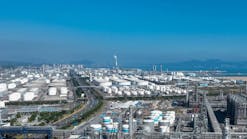European petroleum companies have recently begun publishing environmental reports, showing their progress in reducing pollution, to coincide with their annual reports.
Now Shell U.K. Exploration & Production has gone a step further, with an environmental report for a single operational unit: Mossmorran natural gas liquids (NGL) plant and Braefoot Bay export terminal.
The company transports via pipeline as much as 14,000 metric tons/day of NGL 138 miles from St. Fergus gas terminal, north of Aberdeen, to Mossmorran, near Edinburgh.
Mossmorran produces almost 1.1 billion tons/year of ethane, most of which is sent via pipeline to the Exxon Chemical Ltd. ethylene cracker next door. Some also goes to the nearby BP Chemicals Ltd. cracker at Grangemouth. Also, 1.4 billion tons of propane, 780,000 tons of butane, and 545,000 tons of natural gasoline are typically sent through a 7 km pipeline to Braefoot Bay each year for storage and export by liquid petroleum gas tanker.
Feedback
So why an environmental report for one unit? In the report, Plant Manager Chris van der Spiegel acknowledges a need to be more open and communicate with legislators and local community.
"It is important to share information," wrote Spiegel, "and reassure people that we are sensitive to the issues they may raise. There have been problems in the past including public complaints on issues such as noise and black smoke, and so we are committed to showing how we are responding to the community's concerns and improving our performance."
Shell plans to publish a report on Mossmorran and Braefoot Bay every 2 years, to mark progress in pollution control.
The first report sets out objectives and planned activities. Among the objectives are plans to reduce black smoke and minimize flaring, reduce nitrous oxides emissions from furnaces, and reduce volatile organic compound emissions.
To meet these goals, Shell's flaring task force will develop proposals this year that include installing low NOx burners on the Module 3 furnace in 1997 and double seals on gasoline storage tanks this year and a vapor recovery unit at the marine terminal by yearend 1997.
Local need
Paul Horsman, head of the oil campaign at Greenpeace, said it is good to see an oil company taking this initiative and going ahead of what government demands. He noted that this is still 10-15 years behind U.S. practice.
Horsman said all information on plant performance is valuable but added, "What would be interesting is if oil companies looked at whole life cycle emissions for their products."
A Shell official explained that the Mossmorran/Braefoot Bay report is the first of a batch of single-operation environmental reports planned for Shell U.K. refineries and other large plants.
"An environmental report for every filling station would be taking things too far," the official said, "but major installations such as Mossmorran and our refineries can have a major effect on the local environment, so there is a good reason for reporting our performance to a local audience."
Copyright 1996 Oil & Gas Journal. All Rights Reserved.


